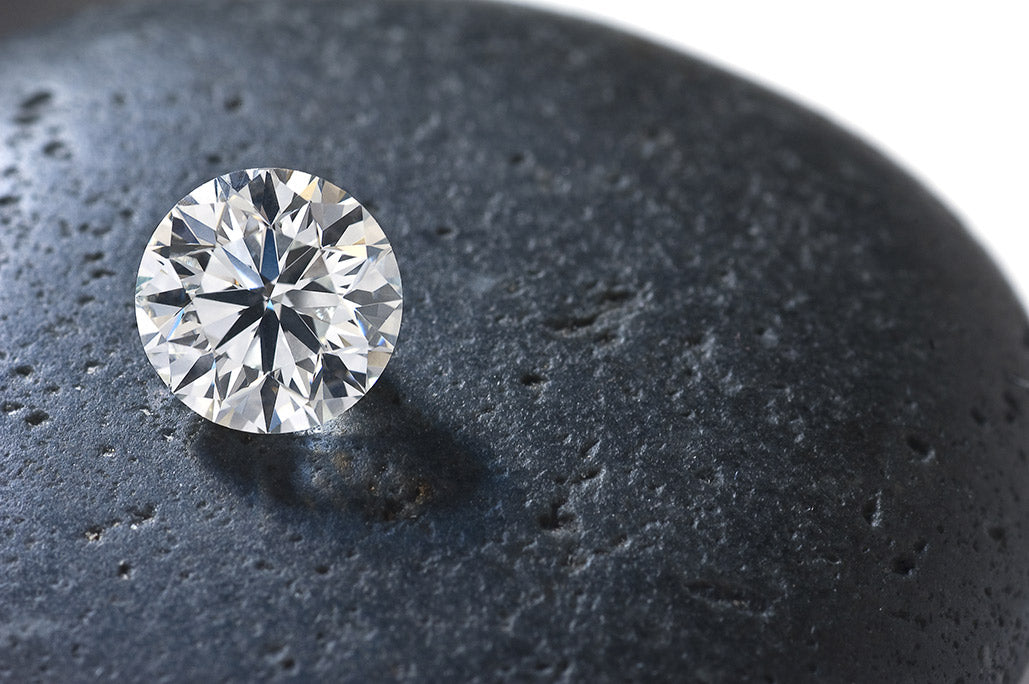Making Sense of Lab Grown Diamond Prices

How much does a beautiful colorless one carat E VS1 lab diamond cost? This E VS1 lab grown diamond is $1475. This E VS1 Mined diamond is $7400. When they discover this, consumers generally have one of two immediate reactions. Wait, why are lab grown diamonds so cheap? Or wait, why are lab created diamonds so expensive? After all you can buy a one-carat CZ for about $12. A one-carat moissanite is as cheap as $50 on Amazon. Or as expensive as $690 on Brilliant Earth. Shouldn’t lab-grown diamonds be priced as low as moissanite or CZ if they are grown in a lab?
We get it. Lab grown pricing is a mystery to most consumers. Here is why lab grown diamonds are cheaper than mined diamonds and more expensive than imitations.

Explaining Lab Grown vs Natural Diamond Price Difference
The Siberian tundra. The deserts of Botswana. Underneath 500 feet of ocean off the coast of Namibia. Diamonds are found in many remote and inconvenient locations. It takes billions of dollars and a decade of effort to develop a diamond mine.
It’s worth it because diamonds are really rare and valuable. They formed more than a billion years ago more than 100 miles in the earth’s crust, far too deep for any mine to reach. Deep in the crust is the only place on earth with enough heat and pressure for diamonds to form naturally. People can only mine diamonds that were brought to the surface in ancient volcanoes.
Still, natural diamonds are so rare that miners have to move 250 tons of earth to find a one carat gem. All that ore needs to be screened and processed to find the one sparkling needle in a haystack. That takes time, energy, and lots of money. When you see the scale of effort required, it’s surprising that mined diamonds don’t cost even more. They have in the past.
The one-carat-plus diamonds found each year would only fill an exercise ball. And the supply of natural diamonds is finite: the deep volcanic eruptions that brought them to the surface no longer occur. In contrast, lab grown diamond production can continue indefinitely. Rarity and the high cost of production are why mined diamonds are more expensive than lab created diamonds.

Why Lab Grown Diamonds Are More Expensive than Imitations
To grow diamond in a lab, you need to engineer an extreme environment with heat or pressure or both to try to get carbon atoms to bond closer together than any other atoms on earth. That’s a really, really difficult challenge.
Basically you are trying to recreate a natural process that takes thousands of years to complete and instead, do it in a lab by creating conditions similar to those found inside the sun. This requires exceptional engineering abilities, resources and patience.
In fact, people have been trying to create diamonds for more than a century. The first tiny sand grain-sized diamonds were grown in a General Electric lab in 1954. It took about 50 years to get to the point where scientists could regularly grow 1 carat lab created diamonds of gem quality. It’s only in the past two years that they have been regularly appearing in jewelry stores.
Because it’s so difficult to grow large lab grown diamonds, you won’t be seeing ten-carat lab created diamonds in jewelry stores any time soon. It’s still very challenging to create large diamonds in the lab.
Cutting and polishing lab grown diamonds is just as challenging as cutting and polishing mined diamonds. Diamond is the hardest substance on earth. You need precise lasers to saw it into shape. And you can only polish it using other diamonds: diamond dust is the only thing that will make its surface shine. And cutters need to skillfully plan how to get the largest possible colorless gem with the fewest inclusions.
Lab-grown diamonds flow through exactly the same cutting workshops and jewelry manufacturers as mined diamonds. When mined diamonds are gone, the jewelry craftsman will continue, working with lab-grown diamonds, just as cultured pearls slowly replaced natural pearls.
You’ll often read that there is no resale market for lab grown diamonds. That simply isn’t true. Both The Real Real and Worthy buy and sell lab-grown diamonds, just as they do mined diamonds. Recent lab grown diamond jewelry for resale on The Real Real includes a platinum Tacori ring with a 1.24-carat lab grown diamond for $4875 and a 17-carat lab-grown diamond tennis bracelet for $18,995. Just as with mined diamonds, larger and better quality lab grown diamonds are more marketable.

Why Diamond Simulants Are So Cheap
None of these things are true for materials that look similar to diamond but aren’t diamond. These imitations or simulants like moissanite and cubic zirconia are not pure carbon and they don’t have the same physical and optical properties as diamond.
They are easy to manufacture and cost only a few dollars a carat to make. That means you don’t have to be careful when cutting them because the raw material is inexpensive. Diamond is 2.66 times harder than moissanite and 5.84 times harder than CZ. That means these stones are much easier to cut and polish. In fact, the process can be automated. The polish of stimulants will scratch more easily over time, since they are softer. CZ isn’t always stable and may yellow over time too.
In fact, the only reason why moissanite and CZ brands aren’t cheaper is marketing costs and profits.
We hope to have answer your question of how expensive are lab grown diamonds? Shop all of Brilliant Carbon's beautiful lab-grown jewelry and engagement rings.

